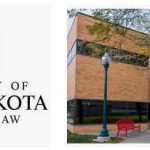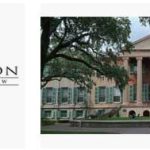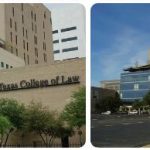The University of South Dakota School of Law was founded in 1901 by the Dakota Territorial Legislature to provide legal education for the people of South Dakota. It began as a two-year program but was changed to a three-year program in 1908. In 1911, the school moved from its original location in Deadwood to Vermillion, becoming the only law school in the state at that time. The school has grown significantly since then, adding new courses and degree programs to its curriculum. In 1971, it became an accredited member of the Association of American Law Schools and began offering a Juris Doctor (JD) degree program. Since then, it has continued to expand its academic offerings and student services, including clinical education opportunities, moot court competitions and international exchange programs. Today, USD Law is home to more than 500 students pursuing both JD and Master’s degrees in law. The school also offers a number of dual degree programs with other graduate schools at USD and with other universities across the country. Students benefit from access to USD’s state-of-the-art library and computer facilities as well as career counseling services provided by the Career Services Office. The faculty is committed to teaching excellence and strives to provide students with an excellent legal education that prepares them for successful careers in law or related fields.
University of South Dakota School of Law is located in the state of South Dakota. As one of the leading law programs, University of South Dakota School of Law has a high average LSAT score of 149-155 when recruiting new students. As a return, the median starting salary for law graduates reaches $49,000 per year. See the following table for detailed admissions information and career profiles of University of South Dakota School of Law.
Admissions: University of South Dakota
The University of South Dakota School of Law has a total enrollment of about 200 students. The student-to-faculty ratio is 11:1, which allows for plenty of one-on-one attention from professors and staff. The school’s acceptance rate is 52%, meaning that out of all applicants, only about half are accepted into the program. The median GPA for incoming students is 3.44 and the median LSAT score is 153. This indicates that the school looks for well-rounded applicants who have demonstrated academic success in their prior studies. In addition to academics, the school also considers an applicant’s personal statement, letters of recommendation and extracurricular activities in order to make their admissions decisions. The University of South Dakota School of Law also offers a variety of financial aid options including scholarships, grants and loans to help cover tuition costs.
| Fall 2019 Admissions and Enrollment Statistics | |
|---|---|
| Total number of full- and part-time applicants | 382 |
| Total number of full- and part-time acceptances | 217 |
| Overall acceptance rate | 56.8% |
| Total number of full- and part-time first-year students enrolled | 78 |
| Number of full-time program applicants | 382 |
| Number of full-time program acceptances | 217 |
| Full-time acceptance rate | 56.8% |
| Number of first-year full-time students enrolled | 78 |
| Number of part-time program applicants | 0 |
| Number of part-time program acceptances | 0 |
| Part-time acceptance rate | N/A |
| Number of first-year part-time students enrolled | 1 |
| Fall 2019 GPA and LSAT Scores | |
| 25th-75th percentile GPA scores for all students | 3.13-3.65 |
| 25th-75th percentile LSAT scores for all students | 149-155 |
| 25th-75th percentile undergraduate GPA for full-time students | 3.13-3.65 |
| 25th-75th percentile LSAT scores for full-time students | 149-155 |
| 25th-75th percentile undergraduate GPA for part-time students | N/A |
| 25th-75th percentile LSAT scores for part-time students | N/A |
Careers: University of South Dakota
| Bar Statistics (Winter and Summer 2018 administrations) | |
|---|---|
| State where the greatest number of first-time test takers took the bar | SD |
| School’s bar passage rate for first-time test takers | 94.9% |
| Statewide bar passage rate for first-time test takers | 95.2% |
| Class of 2018 Graduates | |
| Total graduates | 86 |
| Graduates employed at graduation | 54.1% |
| Graduates known to be employed nine months after graduation | 94.3% |
| Starting Salaries of 2018 Graduates Employed Full-time | |
| 25th percentile private sector starting salary | $42,500 |
| Median private sector starting salary | $49,000 |
| 75th percentile private sector starting salary | $55,000 |
| Percent in the private sector who reported salary information | 46% |
| Median public service starting salary | $42,422 |
| Areas of Legal Practice (Class of 2018) | |
| Percent employed in academia | 4.0% |
| Percent employed in business and industry | 14.0% |
| Percent employed in government | 22.0% |
| Percent employed in all judicial clerkships | 18.0% |
| Percent employed in law firms | 32.0% |
| Percent employed in public interest | 8.0% |
| Percent employed in an unknown field | 2.0% |
| Percent employed in a judicial clerkship by an Article III federal judge | 7.0% |
| 2018 Graduates Employment Location | |
| Graduates employed in-state | 64% |
| Graduates employed in foreign countries | N/A |
| Number of states where graduates are employed | 13 |
| New England (CT, ME, MA, NH, RI, VT) | 1.0% |
| Middle Atlantic (NY, NJ, PA) | N/A |
| East North Central (IL, IN, MI, OH, WI) | N/A |
| West North Central (IA, KS, MN, MO, NE, ND, SD) | 84.4% |
| South Atlantic (DE, DC, FL, GA, MD, NC, SC, VA, WV) | 2.6% |
| East South Central (AL, KY, MS, TN) | N/A |
| West South Central (AR, LA, OK, TX) | 1.0% |
| Pacific (AK, CA, HI, OR, WA) | N/A |
| Mountain (AZ, CO, ID, MT, NV, NM, UT, WY) | 10.0% |
| Employment location unknown | 1.0% |
| Career Services | |
| (Data appear as originally submitted by this school) | |
| Career services operations | CSO provides judicial clerkship and employer OCI; career seminars, meet-the-employer event & resume review by practicing attorneys; employer & public interest panels; alumni contacts; job posting reciprocity with other schools; online and print resources; online Senior Spotlight with graduates’ pictures and resumes; Univ. career services for non-legal positions. |
| Job Type | |
| Bar admission required or anticipated (e.g., attorney and corporate counsel positions, law clerks, judicial clerks) | 77.0% |
| J.D. preferred, law degree enhances position (e.g., corporate contracts administrator, alternative dispute resolution specialist, government regulatory analyst, FBI special agent) | 13.0% |
| Professional/other (jobs that require professional skills or training but for which a J.D. is neither preferred nor particularly applicable; e.g., accountant, teacher, business manager, nurse) | 8.0% |
| Nonprofessional/other (job that does not require any professional skills or training or is taken on a temporary basis and not viewed as part of a career path) | N/A |









